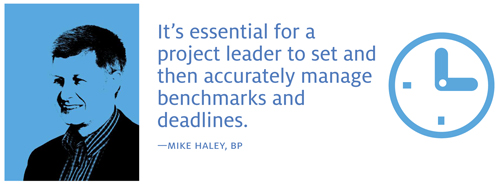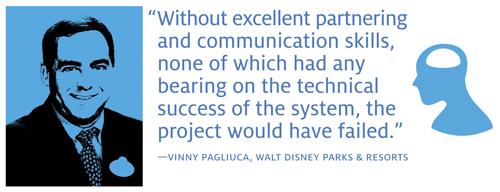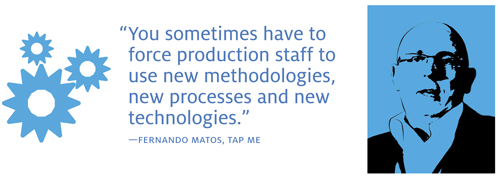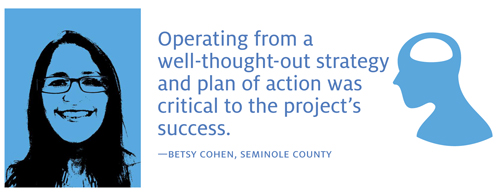Radio frequency identification is a relatively new technology, so most organizations do not have any staff members with RFID in their job descriptions. That means when a plant manager suggests deploying RFID to improve manufacturing efficiencies or a marketing exec comes up with a great idea for using the technology at a promotional event, he or she is often thrust into the role of RFID project leader.
This can be a daunting challenge for someone who is not a technologist and knows next to nothing about radio frequency systems. RFID Journal asked four project leaders who led successful deployments to share the challenges they faced, the skills they relied on and the lessons they learned. While they span a variety of industries, occupations and backgrounds, all had one thing in common: a rock-solid commitment to completing their mission on time and within budget.
While all four are proud of their accomplishments, they’re the first to admit there’s no glory without pain. It was only through careful research, paying close attention to detail, and winning the loyalty of colleagues and the confidence of management that they were able to create an RFID system that met every project goal.
Blazing a Detailed Trail to Innovation
Mike Haley was a consultant in the chief technology office of BP‘s Information Technology & Services group when the oil and gas firm introduced a general companywide track-and-trace initiative designed to apply new technologies to an array of business challenges. As Haley held workshops with management at BP’s refinery in Gelsenkirchen, Germany, about track-and-trace capabilities, isolation tracking emerged from the collaborative discussions as a potential high-value target. Haley introduced the Gelsenkirchen refinery’s management to RFID, and the CTO decided it would be natural for him to manage a project that emerged from the discussions he led.
“Coming up with the idea was the first thing,” Haley says. “We then had to prove to them that this was worth doing.” He did that and more, leading the development, testing and implementation of a brand-new RFID application. The system, called Isolation Tracker, was deployed in September 2010 at the Gelsenkirchen refinery. Isolation Tracker makes isolation processes—a key part of a scheduled maintenance procedure that requires sections of the refinery to be shut down—faster, safer and more accurate. (The solution won the 2012 RFID Journal Award for Most Innovative Use of RFID; see BP Refines Maintenance Operations.)
As RFID system planning began, Haley says, one of the most important decisions he made was to create an internal crossfunctional team. He and Lothar Berger, site IT manager, carefully selected team members who would enable key stakeholders to understand project requirements and identify potential benefits and challenges. They also knew management support would be vital to the project’s successful implementation and operation.
Business development and relationship skills were essential to gain funding and support, Haley says. “Vendor management expertise was important to orchestrate the work of several suppliers, and, of course, problem-solving abilities, leadership skills and good communications were all basic requirements for success.” He and Berger worked tirelessly to keep the yearlong project on track.
During any initiative’s planning, testing and deployment stages, a project leader must pay close attention to system details. This is particularly true for a company like BP, which operates facilities that produce and handle hazardous materials. “If we find a technology and it appears useful to us, I will often have to take it to an ‘intrinsically safe’ specialist company to have the device either remade or rebuilt so we can ensure it meets our stringent certification process,” Haley says. “This is true even if it’s only a simple RFID tag.”
Haley notes that an understanding of end-to-end technical requirements was critical to the project’s success. “That included not only an understanding of tags, readers, Wi-Fi, handheld devices and application integration but also of the unique challenges involved in deploying these technologies in a harsh, heavy metal refinery environment with requirements for intrinsic safety,” he says. Having knowledge of back-end systems, and how to efficiently interface RFID with those assets, was critical as well, he adds.

It’s essential for a project leader to set and then accurately manage benchmarks and deadlines, Haley says. It takes the skill and coordination of an orchestra conductor to ensure that personnel and contractor schedules mesh seamlessly and project work doesn’t interfere with ongoing business activities. “It’s a big challenge,” Haley says, “whether you’re on a platform in the middle of the sea, in a refinery or at a chemical plant.”
Organizing a Cast of Characters
Many project bosses feel like they’re leading a cast of characters as they work closely with colleagues and partners to develop an effective and reliable RFID solution. For Vinny Pagliuca, director of creative costuming at Walt Disney Parks & Resorts, in Lake Buena Vista, Fla., dealing with some of the world’s best-known characters was key to implementing an RFID solution for managing costume inventory.
“I wasn’t actually selected to lead the project,” Pagliuca says. “By default, the project fell completely under my responsibility, so essentially the project was self-generated by my costuming team and, hence, I was the de facto leader.”
The RFID solution is a revamp of a bar-code-based costume inventory system called the Garment Utilization System (GUS). The installation uses EPC Gen 2 passive ultrahigh-frequency RFID tags to track $100 million worth of costumes and uniforms at the company’s theme parks as well as on its cruise ships. GUS also enables a worker to quickly locate a specific garment within a storage room, bring it to an RFID-enabled self-service kiosk, present his or her ID badge and then walk away with the outfit.
GUS might sound like a simple system, but efficient solutions based on sophisticated technologies nearly always look easier than they really are. Developing GUS required Pagliuca to take on a task many managers would shy away from. “Just like the post office, which handles millions and millions of pieces of mail each day, we deal with thousands and thousands of garments,” he says. “It’s a lot of clothing each day that we can’t afford to lose.”
Pagliuca believes that partnering and communication skills were most useful in organizing and managing the project. “The implementation of this project required so many different areas, teams and people to make it a success that without excellent partnering and communication skills, none of which had any bearing on the technical success of the system, the project would have failed,” he says.
“Solving problems as they arose required a great deal of personal tenacity,” Pagliuca adds. “The tenacity factor really tied to fighting through all the pitfalls we found. Keep in mind, we had to communicate a change in our costuming issue process to over 50,000 cast members in over 25 different locations.”

Still, before an initiative is green-lighted, a project leader needs to become familiar with RFID technologies, standards, practices and trends, by reading publications, attending conferences and participating in webinars.
In-depth research helped Pagliuca determine which technologies were best suited for this particular system. He is pleased that he opted to base the system on UHF technology rather than HF components. “Luckily, we made the right call; if we hadn’t, I think we would have fallen behind the curve and found ourselves trying to change out the technology,” he says.
A deep knowledge of RFID also helped Pagliuca understand system requirements and accurately interpret trial results. “Although I could not necessarily get in and tell everyone what frequency we needed to make the antennas work well, or the exact distance the garment needed to be in relation to the readers, I did have quite a good deal of familiarity with all the parameters that needed to be tested,” he says. “I had visited multiple locations where RFID tags were in use and multiple testing locations where RFID tags were being produced and, all things considered, probably had the best balance among the needs of our operators, our IT group and our cast members, the users.” Pagliuca says he also surrounded himself with a team of experts, including technical experts, who could answer deep technical questions as they arose.
One of the biggest technical challenges Pagliuca faced was finding tag locations that would ensure fast and reliable reads on garments ranging from Mickey Mouse costumes to Cinderella gowns and restaurant wait staff uniforms. “If we couldn’t sew it in, we had to figure out a way to either heat-seal it in or put it in a pouch, and then somehow get the pouch to adhere to the garment itself with a belt or something else,” he says. “We actually had to create a manual on RFID placement.”
As project leader, Pagliuca also had to be a business and finance expert, capable of proving that a particular solution really could deliver value to the organization. “To secure funding for the project, we prepared a cost/benefit analysis with an internal rate of return of 25 percent, to be achieved through improved inventory management and labor efficiencies,” he says. “Potential benefits were quantified with targeted savings over the next five years.”
TAPping Into Your Inner Guru
In 2007, TAP Maintenance and Engineering (TAP ME), a Lisbon-based subsidiary of TAP, Portugal’s national airline, began planning a solution to help its staff reliably track and organize the expensive and easy-to-lose engine components used during engine-overhaul operations. At the same time, TAP ME began studying how RFID could be used to increase the speed and efficiency of complex, labor-intensive operations involving the removal, processing and reassembly of hundreds of different and sophisticated components.
Under the leadership of Fernando Matos, TAP ME’s head of information technologies, those two initiatives coalesced into TAP ME’s Mobile Enabled Engine Repair Application (MEERA). Matos, who guided the project from inception to completion, continues to monitor its operation and plan future improvements. “MEERA is now helping us get more data for efficient engine workshop management,” he says (see Portuguese Airline TAPs Into RFID).

It’s up to the project leader, at key stages during planning and deployment, as well as after system launch, to ensure that anticipated goals are being met. “It is one thing to plan what the system is going to do,” Matos says. “Then, you have to really start measuring the key performance indicators and check to see if everything is really OK.”
Matos says he and his colleagues learned many lessons while shepherding MEERA to deployment. They found, for instance, it’s best not to approach such an important and complex project with blind optimism. Seemingly small details, such as tag and reader placement, can take days—even weeks—to refine and perfect. “One must really take care of the small steps,” Matos observes.
Besides serving as a business, financial and technical guru, a project leader must also become a teacher, motivator and diplomat. “You sometimes, for instance, have to force production staff to use new methodologies, new processes and new technologies,” Matos says. “If you have someone who has been trained for 20 years doing something one way and you suddenly tell him he’s now got to do it a new way, if he is not confident on the new system he will keep doing things the old way.”
Learning on the Job
The purchasing division of Florida’s Seminole County is responsible for managing some 10,000 tangible assets, from hospital cots to bulldozers and office equipment. “A few years ago, we were hit very badly with budget constraints, and the property administrator position was eliminated,” says Betsy Cohen, a county procurement supervisor. “That forced me to look into ways to be more effective.”
Cohen knew that an adjoining county was planning to implement an RFID asset-tracking system. “So I started looking into this,” she says. Cohen soon found herself assuming the role of an RFID project leader. “The project was my idea and my initiative,” she says. “We were able to piggyback that [county’s] particular contract. We met with the company representative, and we thought that [the solution proposed] was something feasible for the county.”
In 2011, Seminole County deployed on RFID asset-tracking system that has slashed the procurement department’s workload, as well as the workloads of other county departments that use the same assets (see RFID Helps Florida’s Seminole County Manage Equipment). Achieving that goal required Cohen’s willingness to learn on the job and keep an open mind.

One of the first tasks Cohen faced was learning how inventory processes work within an organization. “This was very important, especially in the process of extracting the data needed to comply with the county policies and procedures, as well as fixed assets mandates,” she says. To ensure the deployment would mesh well with the county’s accounting software, Cohen also had to become familiar with the budgetary aspects of inventory maintenance and depreciation.
To learn about RFID, Cohen attended RFID Journal LIVE! and participated in webinars. “I educate myself as much as I can to keep up with changes in the technology,” she notes. There was an additional benefit to hearing conference speakers discuss their deployments—Cohen picked up helpful RFID project leadership tips.
Operating from a well-thought-out strategy and plan of action was critical to the project’s success, Cohen says. For the most part, system planning, which Cohen worked on with Kellen Erlandson, Seminole County’s asset-management coordinator, proceeded without any significant hitches, though they did hit a major problem. Since the procurement department wanted to track nearly everything the county used, tag attachment emerged as a critical issue.
“With office equipment, you can just peel and attach an RFID sticker, since these items won’t be handled much or moved from place to place,” Cohen says. Road equipment, on the other hand, required tags that could withstand Florida’s heat, humidity, water, dirt, stones and other environmental threats. “We needed to find something more durable, and we needed to find a way to attach the tags,” Cohen says. She inspired her team and partners to become innovators. “We decided to attach sealed tags to the road equipment using a galvanized cable and clamp. This works very well,” she adds.
“In a project of this magnitude, we needed to keep an open mind, admit wrong and embrace change,” Cohen explains, noting that the project required making decisions that would affect many county departments and divisions. “We needed to be sensitive to others and to know those within our sphere of influence and understand their needs.”
It was also essential to maintain a positive attitude, even when jolted by unpleasant surprises, Cohen says. Keeping an upbeat approach “influenced and inspired others to continue when we encountered rough times before, during and after finalization of the project,” she says. “It was important to separate feelings and emotions from the process and to concentrate on the goal,” she says. “Changes are not necessarily well-received, and we needed to embrace change with caution.”
Shortly after the system was deployed, Cohen found herself dealing with a number of skeptical county employees who felt the technology was designed to spy on them. “When we first started tagging the vehicles, the workers in the field thought it was GPS and that we were tracking where they were going,” Cohen says. “We simply explained that this is not a GPS system—it’s just a way for us to inventory their truck or their car.”
Cohen takes pride in the way her system is helping the county become leaner and more efficient. “It’s a lengthy process at the beginning, but the outcome is so beneficial to the organization,” she says. “As a governmental entity, we are responsible to the taxpayers, and it is a good feeling when you have an inventory [database] that matches the financial system.”
When a project leader succeeds by helping his or her organization create a highly functional and productive RFID system, the word spreads rapidly. Seminole County learned a few months ago that news of its inventory tracking solution had traveled all the way to Russia. “We received a request from a delegation from Russia,” Cohen says. Twelve representatives soon arrived in the county. “We were very excited,” she says. “They were very interested in our system, especially in the public-safety arena, where we tagged everything that’s inside fire rescue.”
Cohen, like the other RFID leaders profiled in this story, understands that it takes teamwork to deploy a successful RFID solution. From the first day of planning, Cohen strived to create a feeling of teamwork within every employee involved in and touched by the project. “By including and making them feel part of the team, we were able to gain cooperation and collaboration from them,” she says. “We couldn’t have done it without their involvement and their input. We are very proud of ourselves.”


